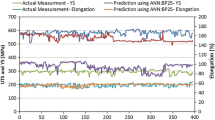This paper describes an interactive neural network model that predicts the quality of cast ceramic products using multiple quantitative and qualitative inputs. This has been done to enable a major sanitary ware manufacturer to reduce product waste by better control of the slip casting process. The input variables describe the raw materials, ambient conditions and line settings for the ceramic casting process. The neural network predictive model assigns one of seven quality categories to the cast based on the input data. This prediction is used by the quality control engineer to make a priori adjustments to materials and line settings so that a good quality cast is produced without trial and error. The neural model can also be used to determine optimum settings of each adjustable input variable in the light of values of non-adjustable input variables.
Similar content being viewed by others
References
Andersen, K., Cook, G. E., Karsai, G. and Ramaswamy, K. (1990) Artificial neural networks applied to arc welding process modeling and control. IEEE Transactions on Industry Applications, 26, 824–830.
Ben Brahim, S., Smith, A. E. and Bidanda, B. (1993) Relating product specifications and performance data with a neural network model for design improvement. Journal of Intelligent Manufacturing, 4, 367–374.
Dinger, D. R. (1990) Expert systems for use in ceramic processing. Ceramic Engineering Science Proceedings, 11, 320–331.
Funahashi, K. (1989) On the approximate realization of continuous mappings by neural networks. Neural Networks, 2, 183–192.
Geman, S., Bienenstock, E. and Doursat, R. (1992) Neural networks and the bias/variance dilemma. Neural Computation, 4, 1–58.
Hornik, K., Stinchcombe, M. and White, H. (1989) Multilayer feedforward networks are universal approximators. Neural Networks, 2, 359–366.
Lambe, C. M. (1958) Preparation and use of plaster molds, in Ceramic Fabrication Processes, Kingery, W. D. (ed.), John Wiley & Sons, New York, ch. 3.
Lapedes, A. and Farber, R. (1988) How neural nets work, in Neural Information Processing Systems, Anderson, D. Z. (ed.), American Institute of Physics, New York, pp. 442–456.
Ikafor, A. C., Marcus, M. and Tipirneni, R. (1990) Multiplen sensor integration via neural networks for estimating surface roughness and bore tolerance in circular end milling. 1990 Transactions of NAMRI/SME, 128–137.
Rumelhart, D. E., McClelland, J. L. and The PDP Research Group (1986) Parallel Distributed Processing: Explorations in the Microstructure of Cognition, Vol 1, MIT Press, Cambridge, MA.
Smith, A. E. (1993) Predicting product quality with backpropagation: a thermoplastic injection moulding case study. International journal of Advanced Manufacturing Technology, 8, 252–257.
Smith, A. E. and Dagli, C. H. (1991a) Controlling industrial processes through supervised, feedforward neural networks. Computers & Industrial Engineering, 21, 247–251.
Smith, A. E. and Dagli, C. H. (1991b) Relating binary and continuous problem entropy to backpropagation network architecture, in Applications of Artificial Neural Networks II, SPIE, Bellingham, pp. 551–562.
Twomey, J. M. and Smith, A. E. (in press) Performance measures, consistency and power for artifical neural network models. Journal of Mathematical and Computer Modelling.
Werbos, P. J. (1974) Beyond regression: new tools for prediction and analysis in the behavioral sciences, unpublished Ph.D. Thesis, Harvard University.
White, H. (1989) Learning in artificial neural networks: a statistical perspective. Neural Computation, 1, 425–464.
Author information
Authors and Affiliations
Rights and permissions
About this article
Cite this article
Martinez, S.E., Smith, A.E. & Bidanda, B. Reducing waste in casting with a predictive neural model. J Intell Manuf 5, 277–286 (1994). https://doi.org/10.1007/BF00123699
Issue Date:
DOI: https://doi.org/10.1007/BF00123699




